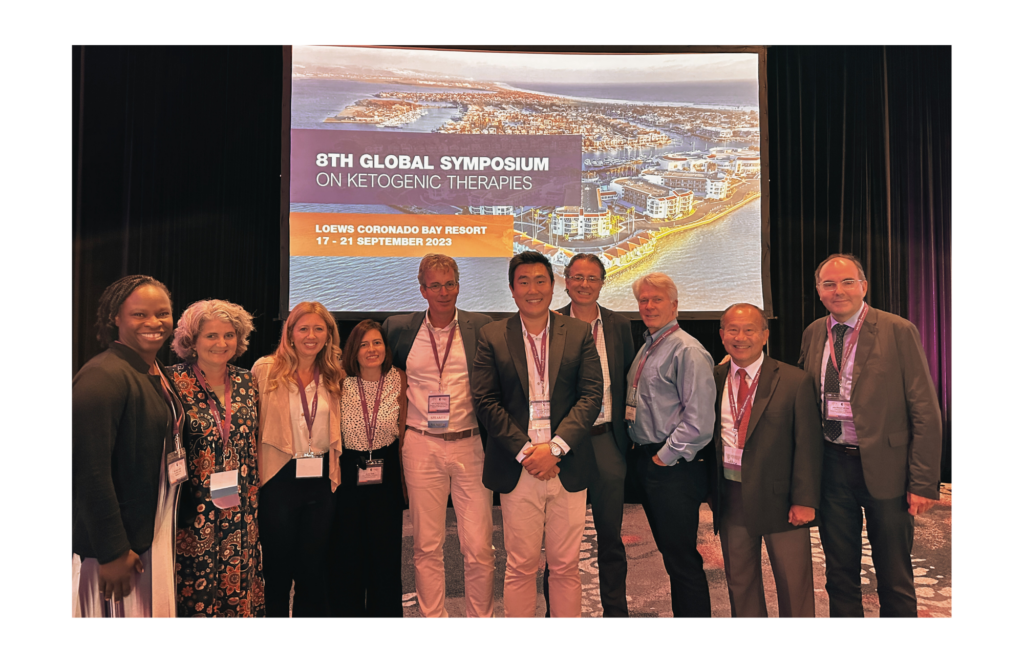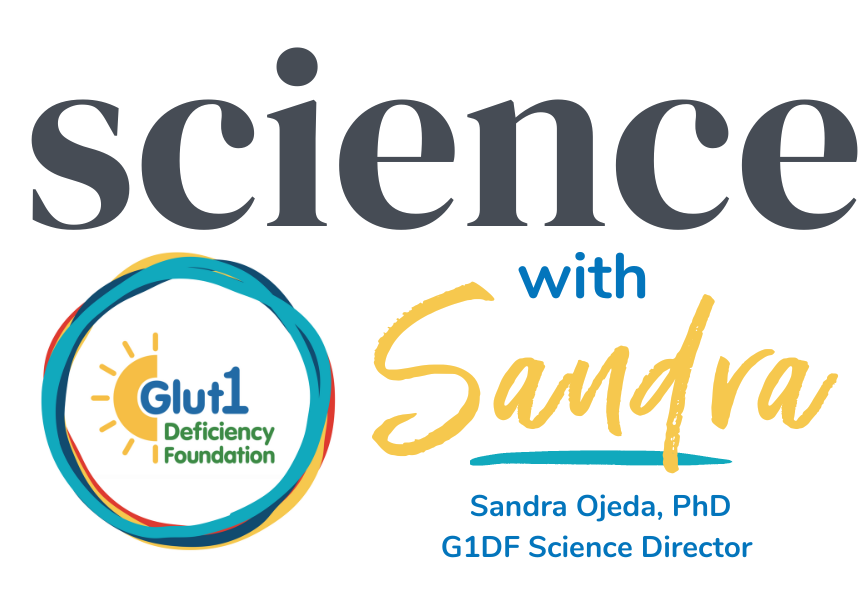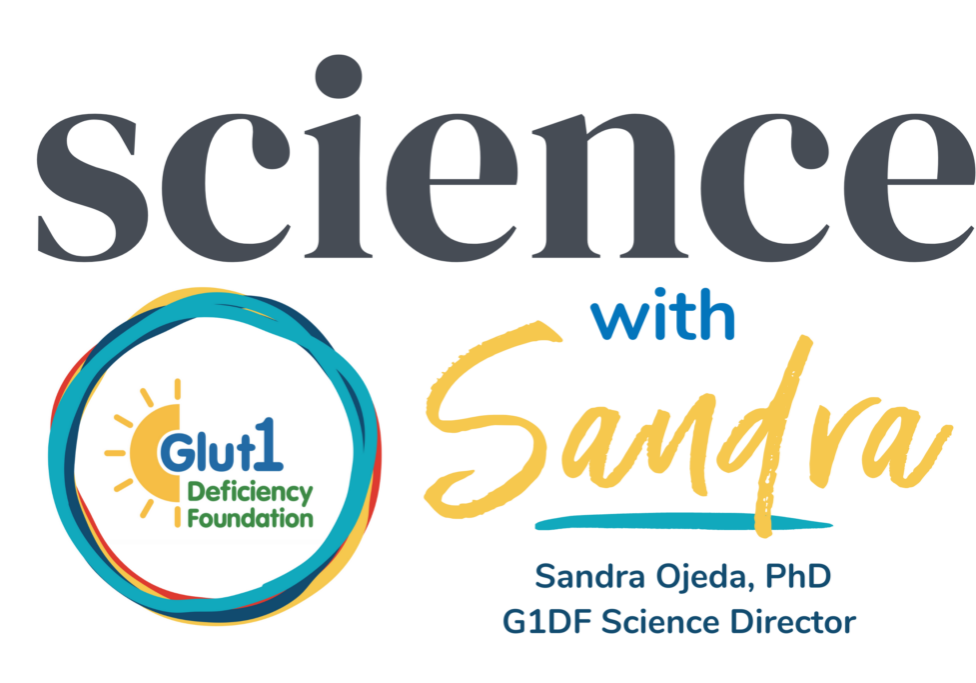8th Global Symposium on Ketogenic Therapies

Hello and welcome to Science with Sandra!
The 8th Global symposium on ketogenic therapies took place on September 17 – 21 at the Loews Coronado Bay Resort in San Diego. I had the pleasure to attend this event with Glenna Steele, our Executive Director, and Maria Rebbecchi, our new Board President.
The symposium was a wonderful opportunity to learn more about the ketogenic diet, its use not only to treat Glut1 Deficiency but other diseases such as cancer and mental health diseases among others. In addition, it was a great opportunity to connect with dietitians and neurologists around the world who are using the ketogenic to treat different conditions. We also had the opportunity to participate in the Family Day that the Glut1 Deficiency Foundation helped organize. It was a great experience to spend that day with families who are using or are interested in using the ketogenic diet, to learn from each other, and to share our experiences.
In this edition of Science with Sandra, I would like to share with you a summary of the conference so that you can learn more about this amazing event.
The conference was hosted by Dr. Jong Rho, the Division Chief of Neurology at Rady Children’s Hospital in San Diego. The Glut1 Deficiency Foundation had the privilege of partnering with the International Neurological Ketogenic Society (INKS), UC San Diego, The Charlie Foundation, Matthew’s Friends, and the International Society of Neurogastronomy for this symposium.
The first plenary session was about glucose and ketones.
Dr. Matt Gentry, our Science Advisor, started the session talking about the importance of glucose, not only for cell energy but for other essential functions like glycosylation, the process by which sugars are attached to other molecules. Glycosylation is essential because it can impact protein folding and maturation, as well as protein function. Dr. Gentry also shared results from his studies in Glut1 deficient mice where he has observed reduced glucose, glycogen and protein glycosylation, which all impact metabolic and neuronal activities.
Other topics discussed in this session were brain lipoproteins, ketones and adenosine. Regarding lipoproteins, Dr. Kimberly Bruce from the University of Colorado discussed how the brain is the most lipid rich organ in the body with about 60% lipids. Lipoproteins are molecules made of proteins and fats (lipids) that carry other lipids in the body. Despite the high concentration of lipids in the brain, lipid metabolism in the brain is not well understood. The brain makes its own lipoproteins, and astrocytes produce lipoproteins from fatty acids that come into the brain.
Apolipoproteins are proteins that bind lipids, guide the formation of lipoproteins, and transport them. One of these apolipoproteins, ApoE4, is associated with a higher risk for Alzheimer’s Disease. Dr. Bruce mentioned that the ketogenic diet is a possible treatment to prevent neurodegenerative diseases in individuals with risk of these diseases due to its neuroprotective effects.
Dr. Susan Masino from Trinity College discussed how ketones provided by the ketogenic diet together with adenosine can have a neuroprotective effect. Adenosine is a naturally occurring nucleoside which is present in various forms in cells of the body and is an essential component of the molecule ATP. A study done on the effects of the ketogenic diet found that the diet increases adenosine and its release from the mitochondria, and that adenosine can also promote homeostasis or stability.
Dr. Natasha Schoeler gave some practical tips to a better ketogenic diet. She discussed how ketone levels are important, however, the optimal level depends on the patient. If the level of ketones helps with seizure control, it does not matter how high or how low the ketone level. In addition, ketone levels can change with extreme heat, excitement, illness, stress, menstruation and hormones.
Sweeteners like sugar alcohols and stevia, present in food, drinks, and medications can increase insulin release in response to glucose. Regarding physical activity and the ketogenic diet, MCT can be used for a quick boost of energy, approximately 45 minutes before activity. Eating a snack after activity can help to recover energy.
The second plenary session was about Neurogastronomy, how the brain creates flavor and why it matters.
Dr. Dan Han and Dr. Tim McClintock shared their knowledge about neurogastronomy. Neurogastronomy is the study of the brain in flavor, senses, texture. The flavor sensation is built from the 5 senses, and taste, touch and smell can be modifiers of flavor. Flavor is linked to language, reward, emotion, memory and motivation.
Some learned flavor preferences:
- Newborns favor sweet flavors
- Salty taste shows up around 4-6 months
- Sweet is universally favored by children
- Preferences for complex flavors (coffee, dark chocolate, beer) develop later
On September 17th, the Neurogastronomy society organized a cookoff, the Gina Mullins Challenge – organized in honor of Gina Mullins, a cancer patient who was a judge of the challenge from year one and who died from cancer in 2017. The inaugural challenge was focused on cancer because cancer patients experience changes in taste and smell often due to chemotherapy treatments which can make the eating experience less pleasant. This year the challenge was focused on the ketogenic diet.
There were two teams competing in the challenge. One team was led by Chef Trevor Morones, an epilepsy patient himself who follows a ketogenic diet. Trevor is the founder of Control Point, a food safety liaison company. The second team was led by Chef Fred Morin, the co-owner and co-founder of Joe Beef group in Montreal, Canada. Maria Rebbecchi, Chef Neil Palliser-Bosomworth, Chef Rachel Finn, dietitian Vanessa Aldaz, her son Max, and I were the judges of the challenge.
The menus were:
Chef Trevor Morones
- Flat iron stake with nuts on top
- Dashi: Zucchini broth with roasted mushrooms
- Desert: Overnight oats – chia and cauliflower “oats” with almond milk
Chef Fred Morin
- Poutine: Pastrami, gravy (bone broth, of meet that was roasted and vegetables)
- Fries (made of almond flour with xanthan gum and crumbled pork rinds chips)
- Desert: hibiscus jello with heavy whipping cream
Both menus were excellent and delicious! It was hard to make a decision but there could be only one winner. The winner of the challenge was Chef Trevor!
The fourth plenary session was about ketogenic diets across the lifespan.
Some of the topics discussed were lactation during the ketogenic diet, the ketogenic diet in infants, and how to optimize the transition from pediatric to adult care while on the ketogenic diet.
Studies done on infants on the ketogenic diet have shown that the recommended ratio for the diet is 3:1. In addition, results show that infants on the ketogenic diet can achieve ketosis. Regarding the use of human milk while on the ketogenic diet, there are two approaches that are currently used:
- Express milk and mix it with ketogenic formula. This approach is accurate and easy to fine tune.
- Nurse and follow with ketogenic formula. This decreases the nursing time, as the ketogenic formula ratio is increased. This approach is less accurate and more difficult to fine tune.
Evidence suggests that it is safe to use human milk while on the diet. Currently, a group of physicians and dietitians is working on writing some practical recommendations on the use of human milk in the ketogenic diet.
Dr. Mackenzie Cervenka shared her experience optimizing the transition from adolescence to adult care.
Some of her recommendations:
- Plan ahead
- Find an adult provider
- Prevent gaps in treatment
- Ask you pediatric neurologist to write a summary care document to share with the adult neurologist
- Avoid reinventing the wheel
- Improve satisfaction (patient, families, caregivers and providers)
- KD work if therapies are continued
- Start thinking about transitioning care at age 10
- Start planning for independent living according to patient development: weighing and measuring foods if on the classical or modified ketogenic diet; reading food labels and counting carbs if on the Modified Atkins diet or low glycemic index diet.
Kath Megaw talked about how to address picky eating in the neurodiverse populations. Picky eating can be impacted by sensory challenges, can affect nutritional and health issues, can affect quality of life and social interactions of the individual and their family.
Some recommendations for picky eaters are:
- Take a multidisciplinary approach with individualized plans
- Take a systematic and gradual exposure to new foods in an environment where the individual feels safe and comfortable
- Provide a positive meal time environment
- Use a routine and predictability approach, avoid sensory overload
- Don’t put too much food on their plates or lunchboxes, modify textures (ex: mince balls instead of bolognese)
Plenary session 5 focused on the Glut1 Deficiency:
The session started with an overview of the disease by Dr. Jörg Klepper. He talked about the symptoms such as:
- cyanotic spells
- absence seizures
- myoclonic seizures
- movement disorders: constant, paroxysmal, eye head movements
- developmental delay: motor, cognition, speech
He also mentioned how the patients’ quality of life is affected particularly in speech, cognition, epilepsy, motor, ataxia, dystonia, PED, and hypotonia.
Dr. Klepper also shared how some slc2a1 gene variants or mutations can lead to different phenotypes, many different CSF glucose levels, and many different ages of seizure onset. Therefore, it is difficult to generalize the symptoms that a patient with a specific variant will have.
He also shared some of the treatments for Glut1 Deficiency on the horizon:
- For patients not on the diet: give them glucose before exercise to prevent paroxysmal exercise induced dyskinesia (PED).
- The use of diazoxide to decrease insulin and allow more glucose into the brain
- Increase red blood cell (RBC) exchange, so healthy RBC can bring glucose into the brain. Not feasible as a long term treatment.
- The use of alternative substrates such as lactate.
Dr. Juan Pascual talked about his most recent studies in Glut1 Deficiency. First, he explained how glucose enters the brain. Glucose is present in red blood cells and plasma. The GLUT1 protein is expressed in RBC and endothelial cells present in the blood brain barrier (BBB). Once the RBC are in close contact with the BBB, glucose is transferred into the brain blood vessels, continuing to be transferred into the glial cells (astrocytes) which also express GLUT1. Astrocytes metabolize glucose and produce lactate which is then transferred into neurons for energy.
Normally in the brain, neuronal excitation is driven by glutamate and inhibition is driven by GABA. When Glut1 Deficiency patients have seizures they present a very typical and well defined electrical activity in a specific area in the brain which is the source of seizures. That area is the thalamocortical somatosensory cortex. Glut1 Deficiency patients show normal synapses and excitation, however, the inhibition is decreased. Dr. Pascual and his team have established that the presynaptic portion of the inhibitory synapse is not functioning correctly. Experiments on brain slices of Glut1 Deficiency mice in the presence of glucose show an increase in the inhibitory neuronal responses.
Studies by Dr. Michél Willemsen in lactate as a possible treatment for Glut1 Deficiency have shown that lactate could serve as an alternative fuel for the brain. A small pilot study was performed with two Glut1 Deficiency patients with a confirmed genetic test and lumbar puncture, and who were not on the ketogenic diet. Patients were infused with lactate and their bloodwork showed increased lactate levels and one of the patients showed decreased seizure activity. Studies on lactate infusion for conditions such as traumatic brain injury (TBI) have proven beneficial and safe. More studies on the possibility to use lactate for the treatment of Glut1 Deficiency are needed.
Dr. Jong Rho talked about the benefits of the ketogenic diet and its neuroprotective effects. Studies on the ketogenic diet comparing it to the anti-epileptic drug phenobarbitol showed that they have a comparable effect on seizures, however, phenobarbitol does not prevent cell death as the ketogenic diet does. The ketogenic diet can decrease cell death providing neuroprotection. The diet can also cause epigenetic effects, which means it can cause changes in how genes work without changing the DNA sequence.
New technologies such as MALDI Mass spectrometry, used by Dr. Ramon Sun in his lab, are allowing scientists to determine the distribution of hundreds of molecules at once directly from tissue sections. Dr. Sun and other scientists in our community with whom he is collaborating are using this technique to study proteins, DNA, and other metabolites to better understand Glut1 Deficiency. Specifically, this technique is being used to understand the glycosylation status in brains of Glut1 deficient mice. Their experiments have shown that glycosylation, as well as glycogen levels in Glut1 Deficient mice are decreased.
Dr. Mark Beenhakker, who studies why electrical activity in the brain becomes uncontrollable in certain diseases such as epilepsy, explained how hypoglycemia can provoke absence seizures and increase thalamic seizure activity in humans and rat models of seizures. In addition, he explained that hypoglycemia activates AMPK, which is a metabolic sensor that maintains energy balance at the cellular level and plays an important role in intertissue metabolic signaling. Dr. Beenhakker is currently performing studies to understand the link between Glut1 and AMPK.
Dr. Valentina De Giorgis did a study showing that the ketogenic diet helps improve quality of life for Glut1 Deficiency patients because it helps with some of the symptoms. The ketogenic diet has also shown positive effects on autism patients regarding improved behavior and emotions. There is also evidence that the diet helps improve sleep quantity and quality in children on the diet treated for drug-resistant epilepsies.
According to studies performed by Dr. Pat Sullivan on traumatic brain injury (TBI), beta-hydroxybutyrate (BHB) seems to restore mitochondria and and mitochondrial respiration. In addition, its effect seems to last over time even after stopping the treatment with BHB.
Plenary session 7 focused on expanding the therapeutic spectrum of ketogenic diets and implementation of the ketogenic diet therapy (KDT) for conditions other than epilepsy and Glut1 Deficiency.
Dr. Jethro Hu and Dietitian Amaral talked about the implementation of the KDT for cancer treatment. Dr. Hu explained how cancer cells have an altered glucose metabolism and how they thrive in the presence of glucose. The ketogenic diet provides a way to reduce glucose availability for cancer cells, decreases nonspecific inflammatory response and increases T-cell mediated immune response. T-cells mediate anti-tumor immune responses.
In addition, it has been seen that the ketogenic diet blocks cancer bioenergetics, biosynthesis and redox.
The speakers mentioned that the best way to start the diet for cancer treatment is to start the ketogenic diet before starting the targeted cancer treatment. They recommend to work with a dietitian, plan one meal at a time, and use a whole foods approach as recommended by the Charlie’s Foundation. The reasoning behind starting the diet before the cancer treatment is because some of the side effects of the diet and the cancer treatment are similar, so it is best to first adjust the diet to minimize the side effects and then start the cancer treatment.
Other conditions in which the ketogenic diet is being studied as a treatment are Multiple Sclerosis (MS), diabetes, ALS, and mental health diseases such as bipolar disorder. Physicians shared their experience in the use of the KDT in all of these conditions, and all of them agreed that the diet is beneficial for their patients.
In the case of MS, for example, studies in a mouse model of MS, the diet reversed motor disability, reduced proinflammatory molecules and promoted myelination. Moreover, a clinical study of MS treating patients with the KDT showed that their bloodwork had improvements and patients reported improvement in their quality of life, fatigue, and MS symptoms.
In the case of diabetes, in a clinical study of Type 2 diabetes and the KDT, the results showed a greater loss of body mass, decrease in HbA1c, improvements in insulin resistance and for some patients it even reversed their diabetes.
The last session of the conference was about the new frontiers for the ketogenic diet and it focused on the gut microbiome.
The microbiome is the collection of all microorganisms, such as bacteria, fungi, viruses and their genes, that naturally live on our bodies and inside us. They contribute to our health and sometimes disease if not in balance. Our microbiome is formed in the first years of life but changes over time influenced by the environment, the diet we consume, and medications we take.
Studies have shown that the microbiome is linked to many components of mental health, brain development, mood/behavior, and neurodegenerative disorders. There are multiple mechanisms for the microbiome to influence behavior such as modulation of neurotransmitters and inflammatory pathways.
As I mentioned earlier, the conference was an excellent opportunity to learn more about the ketogenic diet, the possible use of the diet not only for treating epilepsy and Glut1 Deficiency, but other conditions including mental health. In addition, the conference provided a great space for establishing new research collaborations and reinforcing the ones already in place in our community and with other disease communities.
We thank Dr. Jong Rho and the International Neurological Ketogenic Society for allowing us the opportunity to partner for this wonderful event!
Please let me know if you have any questions at sojeda@G1DFoundation and thank you for visiting our blog.



